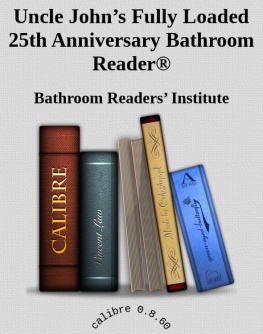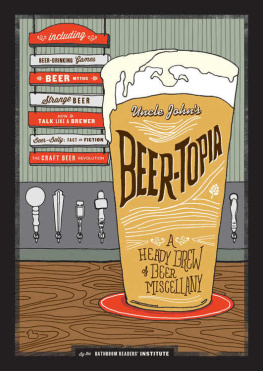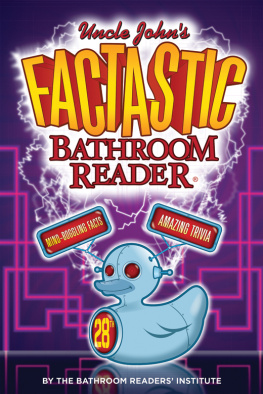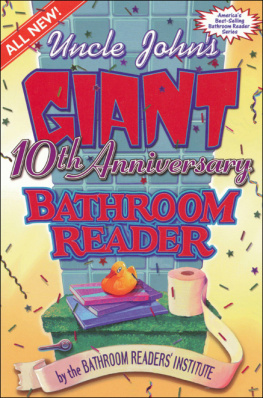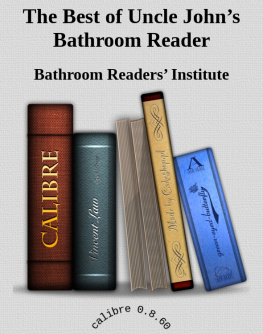Uncle Johns
ULTIMATE
BATHROOM
READER
The Bathroom Readers
Institute
Bathroom Readers Press
Ashland, Oregon
UNCLE JOHNS ULTIMATE BATHROOM READER
Copyright 1996 by Portable Press. All rights reserved. No part of this publication may be reproduced, distributed, or transmitted in any form or by any means, including photocopying, recording, or other electronic or mechanical methods, without the prior written permission of the publisher, except in the case of brief quotations embodied in critical reviews and certain other noncommercial uses permitted by copyright law.
Portable Press/The Bathroom Readers Institute
An imprint of Printers Row Publishing Group
10350 Barnes Canyon Road, Suite 100, San Diego, CA 92121
Printers Row Publishing Group is a division of Readerlink Distribution Services, LLC.
The Portable Press, Bathroom Readers Institute, and Uncle Johns Bathroom Reader names and logos are registered trademarks of Readerlink Distribution Services, LLC.
All correspondence concerning the content of this book should be addressed to Portable Press/The Bathroom Readers Institute, Editorial Department, at the above address.
Honey Bucket, by John Foley, originally appeared in Alaska Magazine. 1992
John Foley. Reprinted by permission of the author.
1995: The Year of the Toilet originally appeared as Gone to Pot: Movies Flush with Bathroom Scenes, by Mick LaSalle. San Francisco Chronicle. Reprinted by permission.
Knifestyles of the Rich and Famous, from Marie Claire magazine. Reprinted by permission of Marie Claire Magazine/Hearst.
Dave Barrys Flaming Toilet. Dave Barry is a columnist with Tropic, the Sunday magazine of the Miami Herald. Reprinted by permission of the Miami Herald.
Killing Mass Transit, Good News for Hitler, Morgans Swindle, Into the Mouths of Babes, from Its a Conspiracy! by The National Insecurity Council. Text
1992 by Michael Litchfield. Reprinted by permission of EarthWorks Press.
Selections from Primetime Proverbs, 1989 by Jack Mingo and John Javna. Reprinted by permission of the authors.
Millennium Madness, The Great Criswell, Is It 2000?, and assorted inserts on the year 2000 from Uncle Johns Indispensable Guide to the Year 2000. Copyright
1996 by Bathroom Readers Press.
Food Questions: How Do They Do That, by Trish Hall. Copyright 1987 by
The New York Times Co. Reprinted by permission.
The Birth of The Simpsons, Marriedwith Children, and Heres the Story, the Munsters from Cult TV, by John Javna. Copyright 1986 by John Javna. Reprinted by permission.
Accidental Hits from Behind the Hits, copyright 1985, by Bob Shannon and John Javna. Reprinted by permission of the authors.
eISBN: 978-1-60710-614-2
THANK YOU!
The Bathroom Readers Institute sincerely thanks the people whose advice and assistance made this book possible.
John Javna
John Dollison
Lenna Lebovich
Gordon Javna
Erik Linden
Melissa Schwarz
Sharilyn Hovind
Larry Kelp
Andy Sohn
Michael Brunsfeld
Erin Barrett
Sherry Powell
Benjamin Brand
Gary Morris
Jennifer Massey
Chris Rose-Merkle
Gordon Van Gelder
Eric Lefcowitz
Leni Litonjua
Morgan Smith
Max, Lucy & Alice
Julie Roeming
Lonnie Kirk
Paul Stanley
Bennie Slomski
Gordon Javna
Thomas Crapper
Jesse & Sophie, B.R.I.T.
and all the bathroom readers
Hi to Emily and Molly!
Special thanks to Leder Norahs


PREDICTION FOR THE YEAR 2000
When Jane cleans house she simply turns the hose on everythingWhy not? Furniture (upholstery included), rugs, draperies, unscratchable floorsall are made of synthetic fabric or waterproof plastic. After the water has run down a drain in the middle of the floor (later concealed by a rug of synthetic fiber), Jane turns on a blast of hot air and dries everything.
Popular Mechanics, 1950
Hiya Gideon! Hiya Sam!
CONTENTS
NOTE:
Because the BRI understands your reading needs, weve divided the contents by length as well as subject.
ShortA quick read
Medium1 to 3 pages
LongFor those extended visits, when something a little more involved is required


AN ARTFUL HOAX
On display: Vincent Van Goghs ear (thats how it was labeled).
Where: In New Yorks Museum of Modern Art in 1935, during the first exhibition of Van Goghs art in the U.S.
Background: Hugh Troy, a New York artist, suspected that most Americans were more interested in Van Gogh the man than they were in Van Gogh the artist. To prove this, he mounted a shrivelled object in a velvet shadow box and wrote: This is the ear which Vincent Van Gogh cut off and sent to his mistress, a French prostitute, Dec. 24, 1888. Then he visited the Van Gogh exhibit, and when no one was looking he put it out on display.
What Happened: The ear was mobbed, while Van Goghs paintings were virtually ignored. It wasnt until later that Troy admitted that he had fashioned the ear out of a piece of chipped beef.
INTRODUCTION
Well, here we are again. Another year, another bathroom reader.
Were wiped out. As usual, it was plenty of work pushing out this latest edition. But it was also a gas.
We at the BRI often feel we have the most satisfying job in the world. We get to spend the year poring through old magazines, newspapers, and obscure books, looking for off-the-wall subjects to write aboutand then we get to field-test the materials.
Amazingly, after nine yearsand over 2,000 pagesof Bathroom Readers, its still easy to find new things to write about. The material keeps on flowing. In fact, we already have almost enough information floating around now to roll out our next volumeour 10th Anniversary Special. (Keep on the lookout for that.)
If youre a longtime Bathroom Reader fan, youve probably already noticed that this edition is bigger than our previous seven volumes (not including The Best of Uncle Johns Bathroom Reader, of course). Weve gotten plenty of requests to add as many pages as possible, so the book will keep you company through more sit-down sessions. And weve done our best to comply.
Keep those cards and letters cominglet us know what you like and send us your own favorite bathroom reading material. We can always make use of it, one way or another.
Happy readingand Go with the Flow!
Uncle John and the Bathroom Readers Institute
You already know these names. Heres where they came from.
C LOROX. In 1913, the Electro-Alkaline Company of Oakland, California, started selling bleach in jugs carried by horse-drawn carts. A supplier pointed out that their name sounded industrialeven dangerous. He suggested combining chlorine and sodium hydroxide (two of the products ingredients), to create Clorox.
BRILLO. From the Latin word beryllus, which means shine.
LEE JEANS. At the turn of the century, Henry D. Lee was one of the Midwests biggest wholesalers of groceries, work clothes, and other items. In 1911, because he wasnt getting shipments of work clothes on time, he decided to build his own factory. In 1924, he started making jeans for cowboys. In 1926, Lees made the first jeans with zippers.


